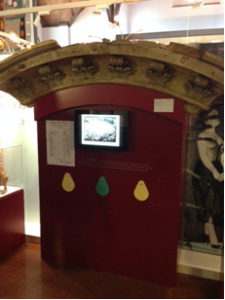August 2015
Lynn Museum produced an ambitious object list for the conservation team earlier this year for their exhibition “Art at the Mart”. One of the key pieces was a chalk drawing of a cockerel. The drawing was produced by Savage’s c1920. It would have been used for the creation of fair-ground pieces and was discovered amongst many working drawings stored at Aikman’s Yard. It had previously gone unnoticed folded up, but is actually a large scale 2.0m x 1.5m!The nature of the work meant that it was never intended to be kept long term and the paper used was low grade and had become very acidic over time.
The chalk drawing prior to conservation depicting the tracing.
The chalk drawing during treatment.
On close inspection, it was decided necessary to employ a specialist paper conservator to carry out the work. Our colleagues from the Norfolk Records Office were consulted to provide advice and a treatment proposal to repair the drawing to make it suitable for display. The treatment began by unfolding the work and flattening it using humidification and lead weights. Tears and gaps were repaired using Japanese tissue paper, dyed and un-dyed and reversible paper adhesive. The colour of the gap fills were decided on using a similar lighting set up in the studio to that in the Lynn museum. The colour of ‘light’, be it natural or artificial, will change pigment colour dramatically. It is important to colour match under similar lighting to that which the object will be exhibited, in order that the gap fill is sympathetic and not obtrusive.
 Recto image of cockerel tracing with repairs.
Recto image of cockerel tracing with repairs.
Treatment work was mainly carried out on the reverse of the drawing. The reverse (recto) revealed evidence of being used as a tracing. Because of this revelation and due to its overall size, the object was professionally photographed since once mounted, the reverse drawing would not be accessible. These professional images of the completed work have added to the important documentation record,making the object more accessible to a wider audience and enabling the key work to be used for exhibition advertising. Once photography was completed, the drawing was mounted on hexagon board for rigidity.
Framing of this large work was an additional challenge. The size of glass required would make the already large frame excessively heavy. Perspex cannot be used in close proximity with chalk due to static. The end result was an aesthetic decision using a traditional framing technique produced by our Design and Technical team. Whilst we cannot permanently exhibit this piece due to its vulnerability, the object will remain mounted and be accessible in store after the exhibition closes.
The chalk drawing during mounting
 The drawing after paper conservation.
The drawing after paper conservation.
Whilst we collaborated with the NRO regarding the remedial work on the chalk drawing, the department was busy dealing with the 3D objects. Many of the organic objects required freezing for pest eradication prior to treatment. Conservation mounts were created to support several hats from the Kings Lynn Costume collection. Pattern’s large and small required surface cleaning. Smaller chalk drawings required conservation mounting. However, the star of the show in equal measure to the cockerel drawing, is the fair-ground pelmet, believed to be part of the interior column décor of a Savage ride.
To our best knowledge the object has never been exhibited before and has been in storage since its accession. The object required cleaning as well as some consolidation and repair. A lot of pigment remained and the vulnerable surface required paint relaying in areas using a flexible consolidant. We worked closely with our Design and Technical team to help with the structural integrity of the object to strengthen it for mounting within the gallery space. A false wall and mount capable of holding the heavy weight of the pelmetwas constructed so visitors can enjoy the object as it would be have been viewed in the past.
The ambitious object list has been a triumph and the exhibition reveals mostly never seen before art works as well as some old favourites. The exhibition will close July 2016. The work undertaken by the NRO took approximately forty hours and was supported and funded by Arts Council England and the Friends of Lynn Museum to whom we are all most grateful. We would also like to thank our colleagues at the NRO for their careful and considered approach and working with us and our Design and Technical team to conserve such a unique drawing.
Savage fair-ground pelmet currently on display at Lynn Museum.




